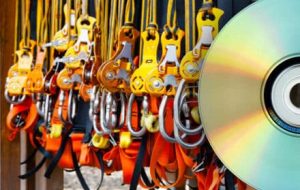Telecommunications
Home More Training Resources OSHA General Industry Training Requirements Telecommunications
OSHA Training Requirements - Telecommunications
This website is not the official or final authority to determine OSHA compliance responsibilities, which are set forth in OSHA standards themselves, and the Occupational Safety and Health Act of 1970. Because OSHA regulations are constantly being added, deleted, and/or revised, you must not rely on this website as the official or final authority of OSHA training requirements; refer to the official OSHA regulations available on OSHA’s website (osha.gov). – See disclaimers.
1910.268 – Telecommunications
(b)(2)(i) – Battery handling. – Eye protection devices which provide side as well as frontal eye protection for employees shall be provided when measuring storage battery specific gravity or handling electrolyte, and the employer shall ensure that such devices are used by the employees. The employer shall also ensure that acid resistant gloves and aprons shall be worn for protection against spattering. Facilities for quick drenching or flushing of the eyes and body shall be provided unless the storage batteries are of the enclosed type and equipped with explosion proof vents, in which case sealed water rinse or neutralizing packs may be substituted for the quick drenching or flushing facilities. Employees assigned to work with storage batteries shall be instructed in emergency procedures such as dealing with accidental acid spills.
(c)- Training. Employers shall provide training in the various precautions and safe practices described in this section and shall insure that employees do not engage in the activities to which this section applies until such employees have received proper training in the various precautions and safe practices required by this section. However, where the employer can demonstrate that an employee is already trained in the precautions and safe practices required by this section prior to his employment, training need not be provided to that employee in accordance with this section. Where training is required, it shall consist of on-the-job training or classroom-type training or a combination of both. The employer shall certify that employees have been trained by preparing a certification record which includes the identity of the person trained, the signature of the employer or the person who conducted the training, and the date the training was completed. The certification record shall be prepared at the completion of training and shall be maintained on file for the duration of the employee’s employment. The certification record shall be made available upon request to the Assistant Secretary for Occupational Safety and Health. Such training shall, where appropriate, include the following subjects:
(1) – Recognition and avoidance of dangers relating to encounters with harmful substances and animal, insect, or plant life;
(2) – Procedures to be followed in emergency situations; and,
(3) – First aid training, including instruction in artificial respiration.
(j)(4)(iv)(A) – Manufacturer’s specifications, load ratings and instructions for derrick operation shall be strictly observed.
(j)(4)(iv)(D)- Only persons trained in the operation of the derrick shall be permitted to operate the derrick.
(j)(4)(iv)(E) – Hand signals to derrick operators shall be those prescribed by ANSI B30.6-1969, “Safety Code for Derricks”, which is incorporated by reference as specified in § 1910.6.
(l)(1) – Employees involved in using high voltages to locate trouble or test cables shall be instructed in the precautions necessary for their own safety and the safety of other employees.
(o)(1)(ii) – While work is being performed in the manhole, a person with basic first aid training shall be immediately available to render assistance if there is cause for believing that a safety hazard exists, and if the requirements contained in paragraphs (d)(1) and (o)(1)(i) of this section do not adequately protect the employee(s). Examples of manhole worksite hazards which shall be considered to constitute a safety hazard include, but are not limited to:
(A) – Manhole worksites where safety hazards are created by traffic patterns that cannot be corrected by provisions of paragraph (d)(1) of this section.
(B) – Manhole worksites that are subject to unusual water hazards that cannot be abated by conventional means.
(C) – Manhole worksites that are occupied jointly with power utilities as described in paragraph (o)(3) of this section.
(o)(3) – Joint power and telecommunication manholes. While work is being performed in a manhole occupied jointly by an electric utility and a telecommunication utility, an employee with basic first aid training shall be available in the immediate vicinity to render emergency assistance as may be required. The employee whose presence is required in the immediate vicinity for the purposes of rendering emergency assistance is not to be precluded from occasionally entering a manhole to provide assistance other than in an emergency. The requirement of this paragraph (o)(3) does not preclude a qualified employee, working alone, from entering for brief periods of time, a manhole where energized cables or equipment are in service, for the purpose of inspection, housekeeping, taking readings, or similar work if such work can be performed safely.
(q)(1)(ii) – Employees engaged in line-clearing operations shall be instructed that:
(A) – A direct contact is made when any part of the body touches or contacts an energized conductor, or other energized electrical fixture or apparatus.
(B) – An indirect contact is made when any part of the body touches any object in contact with an energized electrical conductor, or other energized fixture or apparatus.
(C) – An indirect contact can be made through conductive tools, tree branches, trucks, equipment, or other objects, or as a result of communications wires, cables, fences, or guy wires being accidentally energized.
(D) – Electric shock will occur when an employee, by either direct or indirect contact with an energized conductor, energized tree limb, tool, equipment, or other object, provides a path for the flow of electricity to a grounded object or to the ground itself. Simultaneous contact with two energized conductors will also cause electric shock which may result in serious or fatal injury.
(q)(2)(ii) – Only qualified employees or trainees, familiar with the special techniques and hazards involved in line clearance, shall be permitted to perform the work if it is found that an electrical hazard exists.
(q)(2)(iii) – During all tree working operations aloft where an electrical hazard of more than 750V exists, there shall be a second employee or trainee qualified in line clearance tree trimming within normal voice communication.
(s)(33) – Definition of a Qualified employee. Any worker who by reason of his training and experience has demonstrated his ability to safely perform his duties.

On Site OSHA Training Classes

Online OSHA Training Courses

